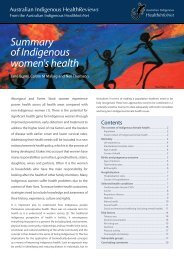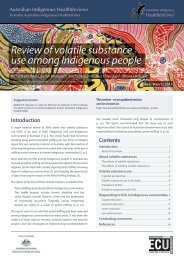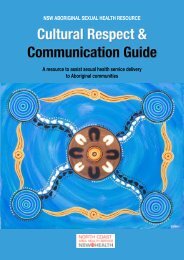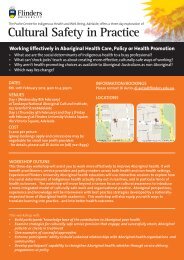hearing loss and the criminal justice system - Australian Indigenous ...
hearing loss and the criminal justice system - Australian Indigenous ...
hearing loss and the criminal justice system - Australian Indigenous ...
Create successful ePaper yourself
Turn your PDF publications into a flip-book with our unique Google optimized e-Paper software.
Senate Inquiry March 2010_________________________________________________________________________________________________________________It is seen as out of social control verbal behaviour that signifies imminent out of socialcontrol physical responses. When <strong>Indigenous</strong> people use broadcasting in a space shared bynon‐<strong>Indigenous</strong> people, what can often result is that <strong>the</strong> police are called to manage this outof control behaviour. When <strong>the</strong> police arrive <strong>and</strong> step in to exert physical control or verballyadmonish <strong>the</strong> <strong>Indigenous</strong> person who is broadcasting, <strong>the</strong> actions of <strong>the</strong> police may be seenby <strong>the</strong> speaker as an unwarranted imposition on <strong>the</strong>ir legitimate speaking rights. This mayresult in retaliatory escalation <strong>and</strong> overt conflict.OUTCOMES OF CROSS-CULTURAL COMMUNICATION EXPERIENCESImportant <strong>and</strong> different outcomes result from <strong>the</strong> different communication styles describedabove. What is experienced as a barrage of negative or critical comment from non‐<strong>Indigenous</strong> people, especially those with <strong>hearing</strong> <strong>loss</strong>, can undermine <strong>the</strong> confidence of<strong>Indigenous</strong> people, or give unintended offence <strong>and</strong> sometimes precipitate conflict.Interviews with <strong>Indigenous</strong> workers indicate that an essential cross‐cultural competency for<strong>the</strong>m is to find ways ofa. avoiding <strong>the</strong> demoralising effect of regular negative feedback <strong>and</strong> negativeattitudes on <strong>the</strong> part of non‐<strong>Indigenous</strong> people <strong>and</strong>b. managing <strong>the</strong> anger <strong>the</strong>y may feel as a consequence of how <strong>the</strong>y are treatedby non‐<strong>Indigenous</strong> people with whom <strong>the</strong>y come into contact.Negative attitudes are communicated in a multitude of individual incremental interactionsthat:a. slowly erode <strong>the</strong> confidence of <strong>Indigenous</strong> people, to a point where <strong>the</strong>y maybecome demoralised, disempowered <strong>and</strong> disengaged orb. result in upset, angry resentful <strong>and</strong> sometimes retaliatory reactions;such ‘retaliation’ appears as inexplicable <strong>and</strong> undeserved from <strong>the</strong> perspective of non‐<strong>Indigenous</strong> people.For non-<strong>Indigenous</strong> people, oneelement of cross-cultural competency isbeing aware that <strong>the</strong>re may be no, orlittle, direct verbal feedback of <strong>the</strong> typeto which <strong>the</strong>y are accustomed.Becoming cross-culturally competentinvolves learning to look for non-verbal<strong>and</strong> indirect cues, <strong>and</strong> to seek out<strong>Indigenous</strong> opinions on <strong>the</strong>ir actions.In contrast, with minimal exposure to negative<strong>Indigenous</strong> feedback, many non‐<strong>Indigenous</strong>people remain unaware of <strong>the</strong> things that<strong>Indigenous</strong> people do not like about what <strong>the</strong>y do<strong>and</strong> <strong>the</strong> way <strong>the</strong>y behave. This can easily lead toover confidence, even arrogance. If <strong>the</strong>y areworking in an <strong>Indigenous</strong> community <strong>the</strong>y maynot know of <strong>the</strong> dissatisfaction with <strong>the</strong>irbehaviour until a crisis point is reached <strong>and</strong> <strong>the</strong>yare asked to leave. Because <strong>the</strong>y have notreceived any forewarning, <strong>the</strong> dissatisfaction with<strong>the</strong>ir behaviour may seem sudden <strong>and</strong> recent, yet<strong>the</strong> concerns had, invariably, built up slowly, overtime. For non‐<strong>Indigenous</strong> people, one element of cross‐cultural competency is being awarethat <strong>the</strong>re may be no, or little, direct verbal feedback of <strong>the</strong> type to which <strong>the</strong>y areaccustomed. Becoming cross‐culturally competent involves learning to look for non‐verbal<strong>and</strong> indirect cues, <strong>and</strong> to seek out <strong>Indigenous</strong> opinions on <strong>the</strong>ir actions._________________________________________________________________________________________________________________25 Phoenix Consulting








